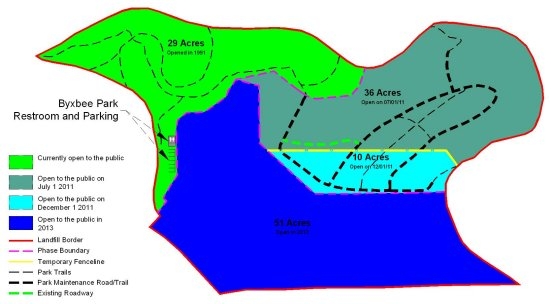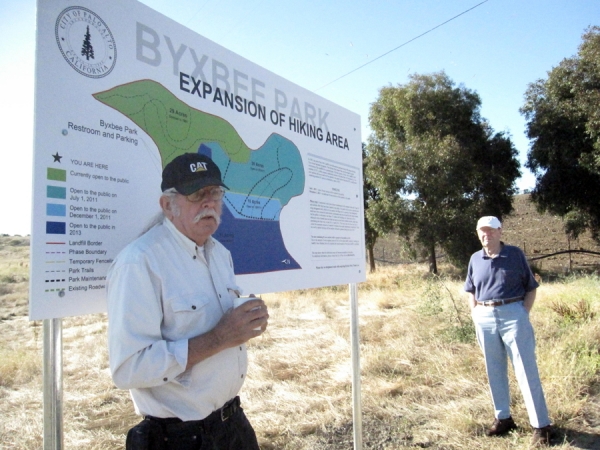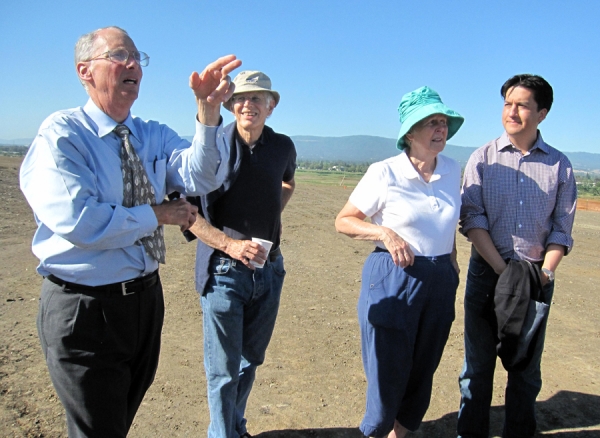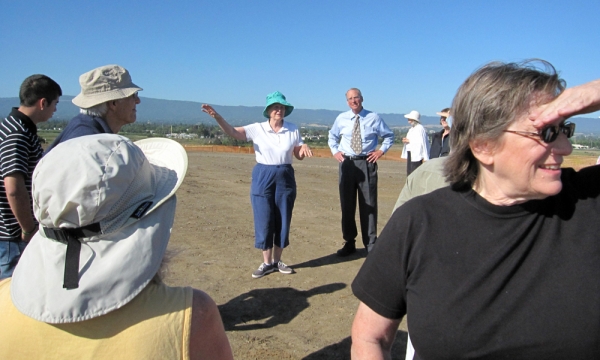After years of anticipation, Palo Alto's nature lovers jubilantly welcomed a new era Friday morning when the city opened up a 36-acre swath of Byxbee Park, essentially doubling the park's size.
City officials, leading conservationists and more than 30 residents marked the occasion with a song about nature and a celebratory hike along the freshly opened path, which leads to the city's newest lookout point.
The area currently amounts to little more than a dirt path leading to grassless knoll, with tractors and survey flags forming much of the backdrop. But in the coming months, it will undergo a transformation as the city adds pathways and native grasses, recreating the pastoral atmosphere that existed at the Baylands site before the city opened a landfill in the 1930s. In the meantime, trails will be marked with flags.
Phil Bobel, the city's environmental compliance manager, said the landfill will officially close July 28, but city officials have already begun the process of opening up new portions of Byxbee Park to the public. A 10-acre site just south of the one that opened Friday is scheduled to become public parkland in December.
Clark Akatiff, who worked at the landfill for 20 years, opened the Friday ceremony with a brief history lesson on the Baylands site and characterized the landfill's closure as an important moment in the city's history. Landfills were once a common site around the Baylands, he said, but most have since been closed and capped.
"This is the last of a breed," Akatiff said. "When this landfill closes, it will be the last of its kind in the area where we live."
The aim now is to "replicate the wonderful prairie that once existed," he said. Mayor Sid Espinosa, who also attended the hike, said that after native grasses are planted in the fall, the place would assume "the pastoral vision that was planned for this park."
Councilman Greg Schmid, who also took part in the hike, called the ridge in the newly opened area one of the most beautiful spots for looking over Palo Alto and the Baylands, particularly during sunset. He encouraged those in attendance to show the site to their friends.
The city expects to convert the entire landfill to parkland in 2013. Officials plan to spend much of next year sealing and capping the area.
Friday's tour was organized by former Councilwoman Emily Renzel, the coordinator of the Baylands Conservation Committee. The city also plans to have an official opening ceremony for the 36-acre site in early September.
In the meantime, the city is still considering building a new waste-to-energy plant on a 10-acre portion of Byxbee Park. Voters will decided in November whether to make this dedicated parkland land available for the new facility, which would process yard trimmings and food scraps and convert them into electricity.







Comments
Crescent Park
on Jul 1, 2011 at 4:23 pm
on Jul 1, 2011 at 4:23 pm
Another dumb move by the city. The landfill had years of use left, and was a far more useful resource for ordinary homeowners than this shabby, unnecessary park.
College Terrace
on Jul 1, 2011 at 4:38 pm
on Jul 1, 2011 at 4:38 pm
"as the city adds pathways and native grasses, recreating the pastoral atmosphere that existed at the Baylands site before the city opened a landfill in the 1930s."
Maybe Walt Disney would believe that statement, but no rational person would. A dump is a dump...even if it is covered up with dirt, then grass, it is a huge toxic pile. This toxic pile will slowly leach into the SF Bay.
This entire site should be reclaimed using plasma arc technology (possibly at a profit to the City). True conservationists should insist on full reclamation. If coal companies are required to do full reclamation, why is Palo Alto being given a pass? Around the Bay, we should be insisting on reversing past mistakes.
Give it back to nature.
Community Center
on Jul 1, 2011 at 9:36 pm
on Jul 1, 2011 at 9:36 pm
"A dump is a dump is a dump?" Go tell that to Mountain View which transformed its huge dump into a beautiful golf course, Shoreline Amphitheater, hiking trails, lakes, and restaurants. Mountain View had vision. Then Google came in and revived the adjacent area. Palo Alto is on the right path finally. .... 46 years of planning.
Previous councils approved the Baylands Master Plan. Get on with it.
Palo Verde
on Jul 1, 2011 at 9:48 pm
on Jul 1, 2011 at 9:48 pm
Dump is a dump,it will always be a dump for bob.
College Terrace
on Jul 2, 2011 at 12:01 pm
on Jul 2, 2011 at 12:01 pm
The dumps around the Bay may be covered over, and made pretty to the eye, but they will continue to flow their toxics into the Bay. Methane, a major greenhouse gas, will continue to bleed out, and a lot of it will not be flared off. The irony is that these dumps are a valuable source of electricity production, as a fuel. Plasma arc is a current technology that can return these dumps to their (almost) natural state...and produce electricity for our cities.
Plasma arc is the greenest of all the currently-proposed 'green' solutions in Palo Alto...especially when compared to anaerobic digestion and simply capping the toxic pile and calling it a park.
Old Palo Alto
on Jul 3, 2011 at 9:21 am
on Jul 3, 2011 at 9:21 am
And at what price? On one hand the city leaders cry fiscal emergency. On the other, they continue to spend millions on non-essential services and projects at the expense of public safety. Unreal.
College Terrace
on Jul 3, 2011 at 11:40 am
on Jul 3, 2011 at 11:40 am
"And at what price?"
If it cannot be done at no net cost to the City, then is shouldn't be done. Also, it should be a completely private enterprise effort (and risk).
Palo Alto has several issues at the dump:
1. We are paying a lot to get rid of good potential fuel. Landfills should be a part of the past, not the future. Plasma arc can use this garbage as a fuel, producing electricity as a product for sale and, as a domestic energy product, a national economic/security benefit.
2. Sewage sludge is currently being incinerated, using natural gas supplies to combust the stuff (at a high cost). The ash from the incinerator is required to be buried in a toxic waste dump (becasue it contains/may contain toxics). Sewage sludge is not a good additive to compost, because there is increasing reistance, among organic compost users, to potential toxic accumulation. Plasma arc eliminates the toxics issue (by destroying/isolating/stabilizing).
3. Used tires are a good source of fuel (along with garbage)for Plasma arc. Tire shops have to pay to get them off their hands...they should be used to produce clean electricity, and to boost the heat content of fuels added to the plasma arc mix. This would allow the plasma arc converter to take care of almost all potential trash sources (including relatively wet ones)...and still be a net producer of electricity.
4. The rent that is suggested for the use of the dump should continue at the current high rate. If plasma arc uses an acre of land for its industrial plant, it should pay current rates; however, if it returns an acre of current dump to a near-natural space, it should be able to offset that cost on an acre-by-acre basis. The same standard should be used when considering anaerobic digestion or cap-and-forget toxic piles (aka 'parkland').
The bottom line on cost is that when all current and future costs are considered, plasma arc should be able to be a cost neutral solution to cleaning up our exisiting toxic pile, and to eliminate landfills, going forward.
Our City Council should start to look at real solutions, not just politically focused groups who want what they want, no matter the costs or inefficiencies (e.g anaerobic digestion). Plasma arc is neither left nor right...it is just a technology that solves problems. We are in need of practical solutions to common problems.
Crescent Park
on Jul 4, 2011 at 3:30 pm
on Jul 4, 2011 at 3:30 pm
> Nature lovers applaud expansion of Byxbee Park
There is nothing natural at all about Byxbee Park ... plus wait until you see the rises in prices of contractors when they have no place left to get rid of their waste and these prices skyrocket.
Making the park bigger is going to demand larger facilities, which they do not have the manpower or facilities now. There is no manpower to patrol for dogs off leash. The current Byxbee park is in bad enough repair to know that a larger park is not going to be anything but an empty space that smells like trash for years.
Crescent Park
on Jul 6, 2011 at 7:16 am
on Jul 6, 2011 at 7:16 am
Wetlands, not a prairie, were filled by Palo Alto's landfill activities. A few decades ago there were over 40 landfills ringing the bay. Most have become parks. A few have become housing and industrial sites. All have closed except ours. Menlo's Bedwell Bayfront Park, Sunnyvale Baylands Park, and Mountain View's Shoreline Park all were former landfills.
Of course, today we would hope that such a decision to fill valuable wetlands would not and could not be made, but alas cities took the easy route years ago and dumped in baylands.
The promise of a park is why the Army Corps of Engineers, the State Lands Commission (who claims ownership), and other state agencies allowed 136 acres of wetlands to be filled. The City should honor that promise. A major policy of the Baylands Master Plan is that there should be no further urban intrusion into the natural areas of the Baylands.
Continuing to run a landfill in our baylands has been a very costly redundant refuse operation, costing millions of dollars annually. The City has no choice but to close the landfill. The State approved a landfill plan and we have reached the limit. Since 1993 the bulk of the city's 185,000 tons of refuse has gone to the regional Sunnyvale SMaRT Station for processing and then on to Kirby Canyon for landfilling. The creation of Byxbee Park is not an extravagance as some earlier contributors have suggested, but is a State Landfill Closure requirement which the Refuse Fund is required to pay. A reserve fund was established for this closure over several decades.
Lopping off 1,600,000 cubic feet of garbage to provide a 10 acre AD site and then dumping it on top of the remaining park is a very damaging and costly. Don't undedicate any of our Baylands Park.
College Terrace
on Jul 10, 2011 at 5:51 pm
on Jul 10, 2011 at 5:51 pm
About 35 acres of dedicated parkland were finally opened to the public on Friday, July 1. It was long, long overdue and certainly worth celebrating, but equally important, it initiates a time to clearly understand more of the history of the city’s misuse of Byxbee Park and its implications as we move toward November.
For 22.5 of those 35 acres, it took 19 years year after the city’s obligation under its lease with the State to open them to the public.
For the balance of 12.5 acres, it took a “mere” 10 years past the city’s obligation.
An additional 10 acres remain 10 year past due in opening, although the city now says that will occur by the end of the year.
Furthermore the city shifted an additional 22 acres from these two parcels, into a third parcel via unauthorized alterations to the original land maps. Consequently it took acreage that was to have been opened for some time to the public as parkland in order to increase area assigned to the ongoing landfill operations.
All this is documented in a formal citizens’ complaint to the State Lands Commission.
Why would the city do this?
In part, because of its insatiable urge to maintain control of Byxbee Park lands and to continue to extract funds from them.
The city can and does charge rent to its Refuse Fund for active areas of the landfill. The rents are at near-market rate, so adding 22 acres by redrawing parcel lines, provides another $2.2 million a year.
But redrawing parcels lines was apparently not enough. In 2007, in another dubious decision, the city unilaterally decided to charge rent on the 46 acres of dedicated, yet unopened parkland described above. That also was in violation of the lease as per the citizens’ complaint, but ratepayers will be paying out an additional $2.1 million for 6.5 years.
The city might never have relinquished control of the landfill if it were not forced to do so. But that time has come.
Despite the diminishing capacity of the landfill and the duplicated expense of shipments to a second landfill, which has a “put or pay” contract through 2021, the city stopped accepting commercial waste thereby moving toward an illegal “trickling closure” and was also apparently blind to the impacts of the community’s effective response to Zero Waste goals, including diversion from landfill.
The result was last year’s $7 million differential, depleting mandated reserves and anticipating additional future shortfalls.
This is part of the current situation related to Byxbee dedicated parklands. Imagine the extreme difficulty – more likely impossibility – of prying the city’s fingers off of former parkland land that has been un-dedicated.
Voters can un-dedicate parkland, but they cannot re-dedicate it.
Nor can an initiative provide some form of “sunset clause” to return un-dedicated parkland to its former state, if action on the land does not occur.
Only the city via the city council can dedicate parkland.
If 10 acres of Byxbee Park were to become un-dedicated, there is almost no chance it would ever be re-dedicated.
College Terrace
on Jul 10, 2011 at 8:31 pm
on Jul 10, 2011 at 8:31 pm
"Wetlands, not a prairie, were filled by Palo Alto's landfill activities"
Yes, Emily, that is a true statement. But then, why are you insisting that these former wetlands be left in a permaent state of a covered over toxic pile? Wouldn't it be far better if this land is reclaimed to its natural state, which is wetlands? As a conservationist, you seem to be acting contrary to your deep beliefs.
I don't get it, Emily.
Crescent Park
on Jul 11, 2011 at 12:29 pm
on Jul 11, 2011 at 12:29 pm
Of course, those of us who battle to save wetlands would love to turn back the clock and regain those wetlands. Alas, we need to at least get the land as park. To return the filled areas in Palo Alto back to the bay would require major excavation of garbage and then major hauling 20 tons per truckload to another landfill. It's logistically challenging, costly and just not realistic. The good news is that most of our Baylands Park is wetlands and we are fortunate to have them.
College Terrace
on Jul 11, 2011 at 12:52 pm
on Jul 11, 2011 at 12:52 pm
"To return the filled areas in Palo Alto back to the bay would require major excavation of garbage and then major hauling 20 tons per truckload to another landfill."
Wrong, Emily. A relativley small plasma arc plant, next to the existing sewage facility could not only deal with the sewage sludge, but also reclaim the existing dump. Yes, the stuff would need to be excavated (of course), but it would be used, on site, as a fuel to produce clean electrcity. The entire site could be reclaimed back to wetlands over time.
Plasma arc is a voracious eater of trash, including previously buried trash...the more the better. Throw in used tires, and solve several environmental problems at the same time...and get us back our wetlands!
I fail to understand why you are avoiding plasma arc...it provides what you want, and it is by far the most environmentally sensitive approach to the issues involved at Baylands. What is the issue, Emily?
Barron Park
on Jul 11, 2011 at 5:12 pm
on Jul 11, 2011 at 5:12 pm
"I fail to understand why you are avoiding plasma arc...it provides what you want, and it is by far the most environmentally sensitive approach to the issues involved at Baylands. What is the issue[?]"
Toxic slag, for one. It's content is unpredictable and uncontrollable and leachable. Replacing a mess with a bigger mess is not a good "solution."
Toxic byproduct gases, for another. Do you know that the chlorine generated in the arc exhaust corrodes away the lining of the reactor chamber, which has to be periodically replaced? Guess what it's doing to lungs in the area. Also, do the pilots at PAO know you want to install a corrosive gas generator near their expensive aluminum birds? Have you asked them what the issue is with that?
College Terrace
on Jul 11, 2011 at 5:46 pm
on Jul 11, 2011 at 5:46 pm
"Toxic slag, for one. It's content is unpredictable and uncontrollable and leachable. Replacing a mess with a bigger mess is not a good "solution."
CB,
There you go again. The slag does contains toxics, as opposed to putting them out in our gardens (as anaerobic digestion does), but the leach rate in undectable by current means. The slag isolates and controls the toxics (that haven't already been destroyed by the plasma arc). All the other alternatives, including cover-and-forget (aka parklands) are MUCH more toxic to our envionment. Anaerocic digestion is much more dangerous, in terms of toxics, because it does not destroy many of the toxins.
CB, you need to do your homework.
Plasma arc is, by far, the most environmentally sensitive of the various proposals to deal with our waste streams.
College Terrace
on Jul 11, 2011 at 6:02 pm
on Jul 11, 2011 at 6:02 pm
"Toxic byproduct gases, for another. Do you know that the chlorine generated in the arc exhaust corrodes away the lining of the reactor chamber, which has to be periodically replaced?"
CB,
Wrong again! The inner lining of the plasma arc converters have overcome that problem, by using brick linings. The gases, including those which result from thermal cracking of PVC, etc., are scrubbed before being released to the syngas generator (then to convert to electricity).
As a former pilot out of PAO, I would have absoutley no concerns about the skin of my plane, since there is no reason to be concerned.
Scare tactics will not work, in the end. They are just propaganda meant to delay the truth being revealed.
Barron Park
on Jul 12, 2011 at 12:16 pm
on Jul 12, 2011 at 12:16 pm
Sorry, Cl, but wrong on both counts. You been overindulging in the salesman's propaganda. You need scientific background.
The slag would be impervious to leaching if it were coated in glass. However, it is a uniform mixture of all the nasties that formed up in the arc exhaust at the moment.
You totally miss my point about the lining, which is not my tender concern for its integrity, but the fact it is exposed to corrosive arc exhaust gases. The arc decomposes the waste stream into its elements, which recombine uncontrollably to form random compounds, or remain as elements. As a former pilot you would not be concerned about it, but do ask active aircraft owners what they think of having the skin and structure of their babies turn into aluminum chloride. If you don't I will.
BTW, nothing is ever "converted into electricity," except in non-techie propaganda. Really, that phrase amounts to baby talk.
College Terrace
on Jul 12, 2011 at 2:05 pm
on Jul 12, 2011 at 2:05 pm
" nothing is ever "converted into electricity," except in non-techie propaganda"
CB,
In the case of plasma arc, the garbage is first converted to syngas (mostly molecular hydrogen and carbon monoxide). The syngas is then used as a fuel in a gas turbine (or internal combustion engine)...which generates electicity. I assumed that most people understood the intermediate steps, but apparently you did not. I hope this walk-through helps you to understand.
"The slag would be impervious to leaching if it were coated in glass. However, it is a uniform mixture of all the nasties that formed up in the arc exhaust at the moment."
Wrong again, CB. The slag forms from the inorganic materials, and it is essentially the melt product, not the gaseous phase. The high temperatures act to vitrify the slag, which explains the reason that the leach rates are so low that they are not detectable by current methods.
The gases leaving the converter will be scrubbed to state standards, period. Go ahead and try to scare the local pilots...they are smarter than you think, and are quite capable of cutting through various scare tactics.
Barron Park
on Jul 12, 2011 at 4:55 pm
on Jul 12, 2011 at 4:55 pm
"In the case of plasma arc, the garbage is first converted to syngas (mostly molecular hydrogen and carbon monoxide)."
Sorry pal, but there ain't very much hydrogen and carbon in concrete or metals. They're a really big part of the stuff in that pile that your arc is supposed to take care of, you know. In fact, the city people didn't charge for dumping concrete. They really wanted the stuff.
Molecular hydrogen?? In the cooling gas? With all the other newly liberated elements? You're joking, right? You got no idea how reactive that stuff is. That's why there are no hydrogen wells. CO but no CO2? Sure.
You know, you could impress us techies out here if you gave us a verifiable energy budget for this process. But we both know why you don't, don't we?
Be sure to tell those pilots that AlCl has no structural strength to speak of.
College Terrace
on Jul 12, 2011 at 5:29 pm
on Jul 12, 2011 at 5:29 pm
It is difficult to try to deal with irrational people, but I will give it one more try:
The syngas produced from plasma arc is mostly mostly molecular hyrdogen and carbon monoxide. Any simple search of the subject will show this. It is not a mystery. The majority of that pile out there in the dump is composed of organic molecules (that is what garbage is mostly made of). Organic molecules, in a plasma arc converter, are converted to syngas. A mechanized presort of the of the dug up stuff, to sort out the concrete is not out of the question, either.
"Molecular hydrogen?? In the cooling gas? With all the other newly liberated elements? You're joking, right? You got no idea how reactive that stuff is. That's why there are no hydrogen wells. CO but no CO2? Sure."
No, not joking. The carbon and hydrogen and oxygen atoms (from organic molecules) are released from their molcular strucures during the thermal cracking process...then they recombine, primarly as molecular hydrogen and carbon monxide (syngas). Yes, really, CB. Most true techies would understand this.
The overriding point is that plasma arc is MUCH less toxic than the exisiting capped toxic leach pile out there, and the proposed anaerobic digestion process (which distributes the existing toxics to our gardens and farms). Aside from this major benefit re: toxics, plasma arc also allows us to reclaim our wetlands.
Barron Park
on Jul 12, 2011 at 6:01 pm
on Jul 12, 2011 at 6:01 pm
"It is difficult to try to deal with irrational people..."
I know, but you're more fun than most. Thanks.